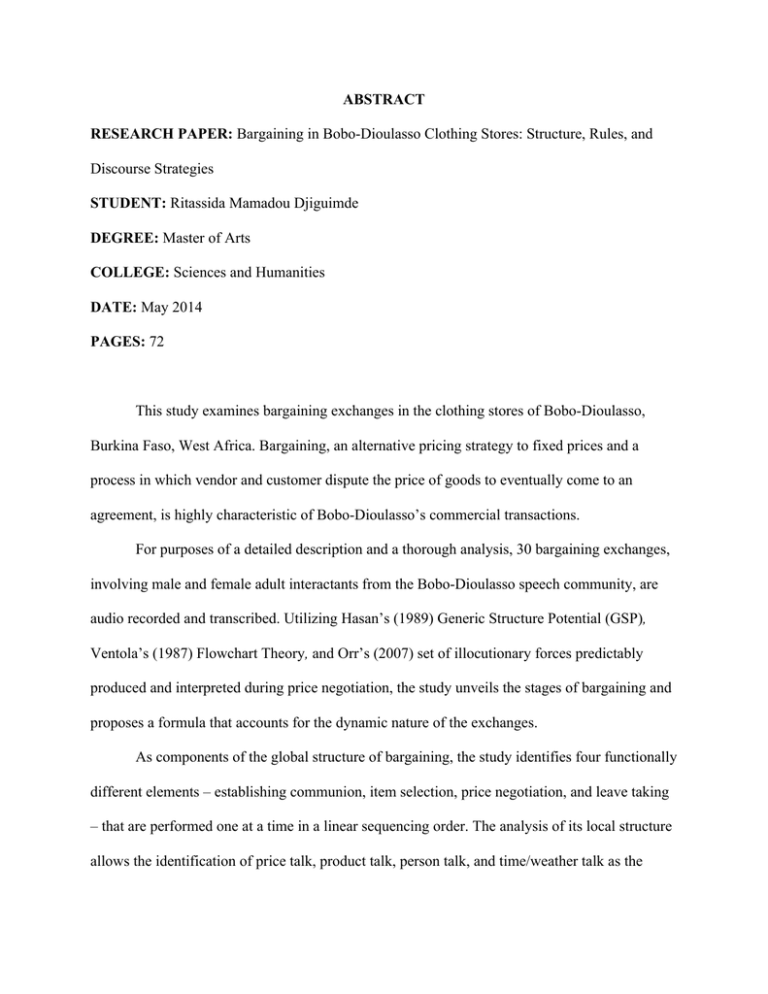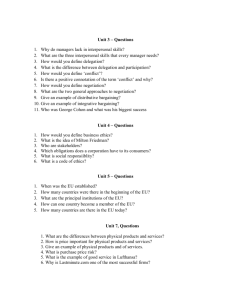ABSTRACT RESEARCH PAPER: STUDENT: DEGREE:
advertisement

ABSTRACT RESEARCH PAPER: Bargaining in Bobo-Dioulasso Clothing Stores: Structure, Rules, and Discourse Strategies STUDENT: Ritassida Mamadou Djiguimde DEGREE: Master of Arts COLLEGE: Sciences and Humanities DATE: May 2014 PAGES: 72 This study examines bargaining exchanges in the clothing stores of Bobo-Dioulasso, Burkina Faso, West Africa. Bargaining, an alternative pricing strategy to fixed prices and a process in which vendor and customer dispute the price of goods to eventually come to an agreement, is highly characteristic of Bobo-Dioulasso’s commercial transactions. For purposes of a detailed description and a thorough analysis, 30 bargaining exchanges, involving male and female adult interactants from the Bobo-Dioulasso speech community, are audio recorded and transcribed. Utilizing Hasan’s (1989) Generic Structure Potential (GSP), Ventola’s (1987) Flowchart Theory, and Orr’s (2007) set of illocutionary forces predictably produced and interpreted during price negotiation, the study unveils the stages of bargaining and proposes a formula that accounts for the dynamic nature of the exchanges. As components of the global structure of bargaining, the study identifies four functionally different elements – establishing communion, item selection, price negotiation, and leave taking – that are performed one at a time in a linear sequencing order. The analysis of its local structure allows the identification of price talk, product talk, person talk, and time/weather talk as the topics elaborated upon. Though the quantification of the types of talk reveals that price negotiation is dominated by price talk, it also demonstrates that the production and interpretation of all kinds of talk align with the basic features of negotiation which are soliciting, making, and evaluating an offer. This finding not only shows the formulaic and rule-governed nature of the exchanges, but also demonstrates the degree to which linguistic elements work conjointly with socio-cultural elements in the production and interpretation of discourse. The analysis of the identified set of illocutionary forces reveals that the double-intent negative evaluation/offer solicitation move dominates price negotiation, has the most dynamic nature, and incorporates the most discourse strategies. The description of the bargaining greeting, leave-taking, person talk, time/weather talk, and solidarity and power terms of address illustrates the importance of interpersonal relationships in bargaining in the Bobo-Dioulasso context. The study of bargaining, as a cultural artifact, is a potent method to track social changes within the Bobo-Dioulasso community. As a spoken genre, its description and analysis permit language learners to better decipher the meaning of texts in this genre and to foster their integration in discourse communities where this genre is prevalent.





